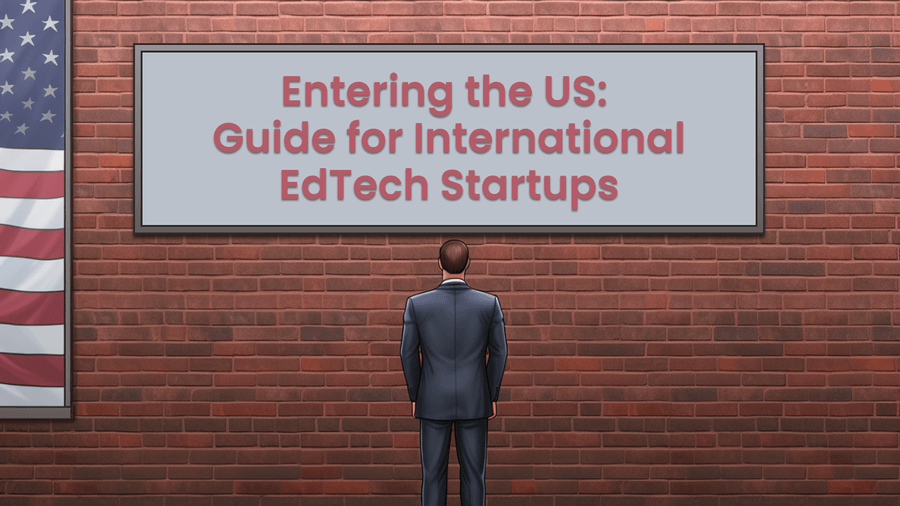Part 1. Why the US Market?
First of all, America offers amazing business opportunities because of its size, growth and global dominance.
We’re all well aware of that. Yet, let’s look at the numbers.
According to Zippia, the US tech market accounts for 35% of the total world market. Impressive percentage for a country, isn’t it?
What’s more, the technology industry is in second place after healthcare in the local market.

The size of the US market is just one of the reasons. Startups that consider going to America will also have access to more capital, a bigger and more dynamic labor pool, and many other benefits.
For example, American investors are increasingly getting interested in European companies.
Sifted claims that 2023 has seen US funds intensifying their focus on Europe, establishing bases, and increasing the venture capital they funnel into European businesses.
According to Forbes, this is because hubs like Silicon Valley become too expensive.
Besides, it’s essential for business to be seen as a global player.
Enhancing your global footprint can automatically hone your reputation. And one of the best places to do so is America.
“Having the Silicon Valley office on our website helps a lot for our reputation to show we’re not just a little startup from Leipzig” says Karsten Beyer, COO for DataVirtuality, a data warehousing solution. “It shows that we’re a global player and that we can serve customers globally.”
As for EdTech, North America dominated the market and produced the majority of global revenue in 2022.
Over the next five years, it will account for 46% of the market’s growth.
The US will remain North America’s key EdTech market.
According to Global Data, it had total revenues of $69.9 billion in 2022, representing a compound annual growth rate (CAGR) of 16.3% between 2017 and 2022.
Where to boost your EdTech startup if not there?
If you want to learn more, there are articles on our blog, where we dive into the global EdTech market and analyze K-12 market prospects in the US. Take a look!
Part 2. Challenges & Solutions
In this part, we’ll explore common challenges companies face in the US market and how to overcome them.
Fierce Competition
Providing outstanding opportunities, the US market is very competitive. This can’t but create extra challenges for business expansion.
It’s a little bit of a double-edged sword. However, there’s no surprise and it doesn’t mean success is impossible.
Go-to Strategy
You don’t need to reinvent the wheel and release a brand-new product to break into the Edtech market. Effective positioning and product distinction are necessary, though.
There are differences between the American and European markets. Be prepared to shift and shape your products, services and sales to the preferences of the locals.
What’s more, companies have to reposition their products and services to emphasize their increased educational value.
In this case, doing thorough research is a must. Comb through market and industry reports, analyze competitors in different parts of the US. Only then create a marketing strategy to sell in America.
Lack of Funding
We must say that funding is not always necessary. For example, Kahoot (Norway) nailed it without relying on investors initially.
This shows that success in entering a new market can be achieved through various approaches, such as leveraging existing resources and partnerships, strong product offering and effective marketing strategies.
Yet, we’ll not underestimate funding as it can be extremely helpful or even vital for some edtech startups.
Go-to Strategy
Start by joining incubators or accelerators. Search for local investors or a strategic partner to assist you with connections.

Hiring Issues
The question is: Who do I need to hire?
And do I need to hire at all?
Go-to Strategy
Having US-based founders would be great for a startup that doesn’t have a founding team yet. But usually businesses that think about joining the US market already have it.
These startups need local assistance with company growth, sales, and strategy. because a thoughtful approach to internal communication is important.
For this purpose, landing teams can act as culture carriers. Also, local hires can be helpful in understanding the market and local regulations.
Working with Requirements
Quality is important. And, which is no less important, meeting the requirements. Compliance with edtech standards and protocols is a crucial part of it.
The US market is basically a patchwork of smaller local markets with various regulations, corporate cultures, legal frameworks and requirements.
Going through all of these may seem like an uphill struggle, especially for an EdTech startup.
For example, you’ll need to wrap your head around documents such as Request for Proposal (RFP), especially if you’re an LMS vendor or your company is seeking assistance. We’ll cover this in more detail in our next article.
Go-to Strategy
For this purpose, assess the technical side.
For instance, is your design compliant with WCAG level AA (US & international accessibility standard)?
How efficient is your code?
Can your product be integrated with other LMS/SIS? And many other aspects.
Wrapping up
All in all, navigating the US market is complicated, but worth it. And the right approach will lead you to outstanding benefits.
As experts in EdTech, we have first-hand experience with all these challenges.
We get it, we’ve been there. We know how to deal with it.
That’s why we can make it easier for you and pave the way for your success in America.
To help your business succeed, we offer code review services, eLearning integration solutions, consulting, and much more.
Talk to our experts and get the answers you need.




